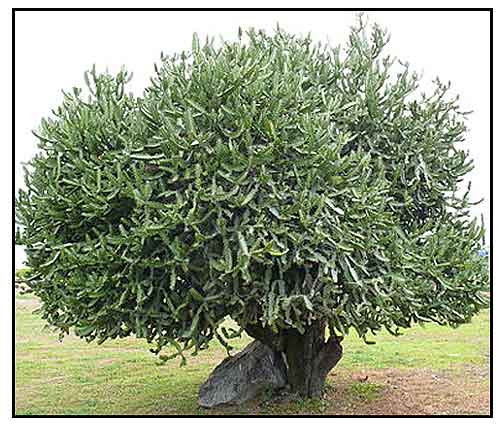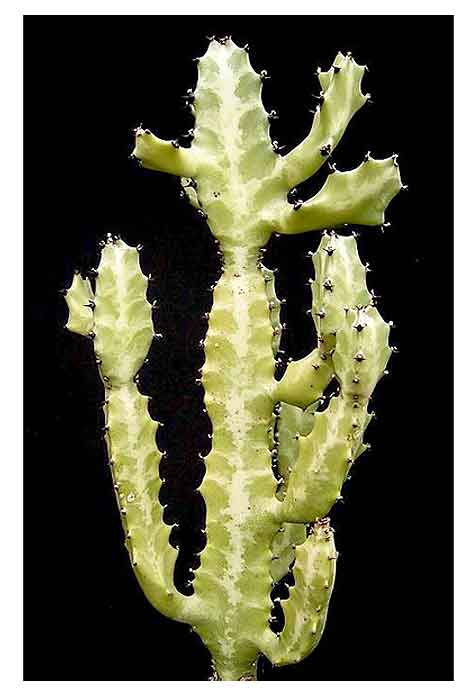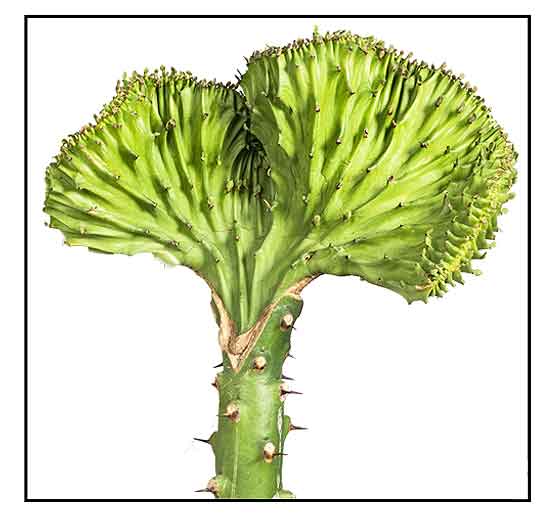 Gen info Gen info
- The genus Euphorbia (family Euphorbiaceae) is the third largest genus of angiosperm plants comprising about 2000 recognized species. (9)
-
Euphorbia lactea is a species of spurge native to tropical Asia.
- It is one of the most common succulent euphorbias in cultivation.
- Despite being toxic, the latex is the most valuable product obtained from Euphorbia species. It contains biologically active natural compounds, such as triterpenoids.
- Although succulent and spine-bearing, it is not a cactus.
Botany
• Euphorbia lactea is an erect shrub growing up to 5 meters (16 ft) tall, with succulent branches 3–5 centimeters (1.2–2.0 in) diameter, ridged, with a triangular or rhombic cross-section; the ridges are spiny, with short spines up to 5 millimeters (0.20 in) long. Leaves are minute, and soon deciduous.
 • A leafless, succulent shrub with angled stems and short, brown to black spines. Stems are usually dark green marbled with white or pale green. Flowers are yellow, and very small to insignificant. There are no leaves (some compilations mention minute and deciduous) leaves. Fruits are three-lobed capsules, rare or absent in cultivation. Sap is copious, milky and corrosive. (6) • A leafless, succulent shrub with angled stems and short, brown to black spines. Stems are usually dark green marbled with white or pale green. Flowers are yellow, and very small to insignificant. There are no leaves (some compilations mention minute and deciduous) leaves. Fruits are three-lobed capsules, rare or absent in cultivation. Sap is copious, milky and corrosive. (6)
Distribution
- Cultivated, not naturalized.
- Native to Sri Lanka and India.
- Grows primarily in seasonally dry tropical biome.
- Ornamental cultivation.
Constituents
-
GC-MS analysis of ethyl acetate extract of latex identified 1H-Cycloprop[e]azulen-4-ol, decahydro-1,1,4,7-tetramethyl-, [1ar- (1aà,4á,4aá, 7à,7aá,7bà)]- a tricyclic sesquiterpenoid and 2,6-Octadiene, 2,4-dimethyl- an aliphatic hydrocarbon. (see study below) (8)
- Co-TLC and spectroscopic studies of above ground parts
identified 12-Deoxy-4.beta.-hydroxyphorbol-13-dodecanoate-20-acetate-24-methylene cycloartenol, euphorbol hexacosanoate, tinyatoxin, ingenol triacetate, resiniferonol-9,13,14-orthophenyl acetate and 12-deoxyphorbol-13/2-methyl/butyrate-20-acetate. (12)
Toxicity
- All parts of the plant contain a poisonous milky latex. The sap causes skin rash and blisters, and intense burning. Contact into the eye can cause temporary blindness. Sharp spines can cause mechanical injury. For eye exposure to sap, rinse with water for 15 minutes, and seek medical consultation. (6)
 - Ocular Inflammation / Keratopathy and Uveitis: Study reports on the spectrum of clinical findings in patients with ocular inflammation caused by plant sap from Euphobia species. Candelabra cactus (E. lactea) can cause keratopathy with variable degree of uveitis. Although Euphorbia keratopathy and uveitis seem self-limited when managed supportively, blindness can occur, especially in neglected cases. Patients working with the plant should wear eye protection. Eye contact may cause burning pain, photophobia, lacrimation, which may worsen over hours or days despite irrigation. With supportive therapy and close observation, the condition usually resolves completely within 1 to 2 weeks. Some patients might require treatment with antibiotic drops or ointment, along with cycloplegic and steroid drops. (7) - Ocular Inflammation / Keratopathy and Uveitis: Study reports on the spectrum of clinical findings in patients with ocular inflammation caused by plant sap from Euphobia species. Candelabra cactus (E. lactea) can cause keratopathy with variable degree of uveitis. Although Euphorbia keratopathy and uveitis seem self-limited when managed supportively, blindness can occur, especially in neglected cases. Patients working with the plant should wear eye protection. Eye contact may cause burning pain, photophobia, lacrimation, which may worsen over hours or days despite irrigation. With supportive therapy and close observation, the condition usually resolves completely within 1 to 2 weeks. Some patients might require treatment with antibiotic drops or ointment, along with cycloplegic and steroid drops. (7)
- The toxicity can remain high even in dried plant material.
Prolonged and regular contact with the sap is inadvisable because of concern for its carcinogenic nature.
- Euphorbia Sap Keratopathy / Possible Mechanism: Study reports on four cases of Euphorbia sap causing anterior segment toxicity. Initial contact with the sap caused punctate epitheliopathy. Patients complained of immediate burning and photophobia, but no visual loss. Treatment consisted of topical antibiotics, pressure patching, or a bandage contact lens. Euphorbia sap contains a diterpenoid diester, which exhibits antineoplastic activity in rodents. The progressive corneal epithelial sloughing may be secondary to the antineoplastic effects of the sap. (10)
Properties
- Toxicity: All parts contain the poisonous latex.
- Studies have suggested cytotoxic, anti-migratory, anti-inflammatory, anticancer, fibrinogenolytic, larvicidal, antiviral properties.
Parts used
Leaves, latex.
Uses
Folkloric
- No folkloric medicinal use reported in the Philippines.
- In India, hot poultice used for rheumatism.
Others
- Agri-horticulture: Used as hedges.
Studies
• Cytotoxic / Anti-Migratory: Study evaluated a hydroalcoholic extract of E. lactea for anticancer potentials, focusing on cytotoxic and anti-migratory activities using a migratory competent head and neck cancer cell line HN22 as invitro model. MTT assay revealed statistically significant and dose-dependent cytotoxic activity against HN22 cells. Flow cytometry analysis of extract treated HN22 cells revealed increase in sub-G1 population, suggesting a cytotoxic effect, likely involving an initiation of apoptosis in the cell line. Wound healing assays suggested anti-migratory activity against HN22 cells. Results suggest a candidate for further studies into its anticancer potentials. (3)
• Tirucallol / Anti-Inflammatory Triterpene / Latex: Latex of Euphorbia lactea has been used for inflammation in the Dominican Republic. Tirucallol, a tetracyclic triterpene isolated from its latex, suppressed ear edema in a mouse mode in a dose-dependent manner, and affected the influx of polymorphonuclear cells in response to topical application of 12-O-tetradecanoylphorbol-acetate (TPA) in the mouse ear. Results suggest the tirucallol (0.3%) present in E. lactea latex exerts a topical anti-inflammatory effect invivo, via a mechanism related to neutrophil migration and control of production of NO and its effect on expression of iNOS. (4)
• Glycosylated Protease / Fibrinogenolytic / Latex: A dimeric protease, EuP-82, was purified from E. lactea latex. Since its proteolytic activity was inhibited by a serine protease specific inhibitor (PMSF), EuP-82 was classified as a serine protease. It showed fibrinogenolytic activity at pH11 and 35°C, with a broad range of pH stability from 4 to 12. Results showed EuP-82 has potential medicinal use in thrombosis, since the enzyme has fibrinogenolytic activity and high stability. (5)
• Larvicidal Against Mosquito Vectors / Latex: Study evaluated E. lactea latex for larvicidal activity against three mosquito vectors, safety to non-target organisms, bioassay guided fractionation, and GC-MS analysis of active fraction. An ethyl acetate extract of latex showed effective activity against larvae of An. stephensi, Cx. quinquefasciatus, and Ae. aegypti with LC50s of 21.01, 25.65, and 49.69 mg/L. The extract was found safe to aquatic mosquito predators Notonecta sp. N. cincera, Dragon fly nymph, D. harrissi and L. indicus. (see constituents above) (8)
• Anticancer: Study of n-hexane fraction of E. lactea extract isolated four triterpenoidal compounds: friedelin (1), friedelan-3ß-ol (2), taraxerol (3) and friedelan-3α-ol (4). The compounds were evaluated for cytotoxic activities against several cancer cell lines. Compounds exhibited dose-dependent cytotoxic activity against HN22, HebG2, and HCT116, with marginal cytotoxicity in HeLa cells. Compound 2 exhibited most prominent anticancer effect against HN22 cells. Compound 2 induced cell cycle arrest at S-phase. Results suggest compound 2 harbors anticancer activity. (11)
• Effect on HIV Type 1 Reactivation / Diterpenes from Latex: The persistence of latent HIV-infected cellular reservoirs represents a major hurdle to virus eradication in patients with highly active antiretroviral therapy (HAART). HIV-1 reservoirs are long-lived resting CD4+ memory cells containing virus latently integrated. Reactivation therapy has been suggested to purge viral latency. Bioassay-guided study of ethyl acetate extract of Euphorbia laurifolia yielded two isomeric diterpenes that showed differential activity over HIV-1 reactivation. A compound was also isolated from Euphorbia lactea, which showed potent HIV-1 reactivating effect. (13)
Availability
Cultivated.
|

![]()






